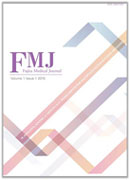Objectives: Patients with disseminated intravascular coagulation (DIC) due to sepsis often develop cerebral infarction; but the frequency, mechanism of onset and prognosis have not been fully elucidated. We reported courses and characteristics of septic DIC cases hospitalized in our hospital in the present study.
Methods: Patients with septic DIC who underwent brain imaging were selected. Vital signs, disorders of consciousness and blood test results at the time of onset were compared between cases that developed cerebral infarction (cerebral infarction group) and those that did not (non-infarction group).In cases of cerebral infarction, the site and the size of the infarct lesion were also described.
Results: In 27 septic DIC patients who underwent brain imaging, eight patients had cerebral infarction. Although the percentage of patients who survived in the cerebral infarction group (2/8, 25%) was lower than that in the non-infarction group (7/17, 37%), , no significant difference was observed as both group showed poor prognoses. Those two patients who survived in the cerebral infarction group had severe consciousness disturbance and poor functional prognosis. Although the body temperature was significantly lower and the blood pressure was higher in the cerebral infarction group, no significant difference was found in general blood tests, so we thought it would be necessary to look for other markers that could be indicators for the risk of cerebral infarction.
In the cerebral infarction group, two cases had a single lesion, and six cases had multiple lesions. Of the latter, two cases had massive lesions with a diameter of 1.5 cm or greater, four cases had only small lesions with a diameter of less than 1.5 cm, and two cases had a mixture of both. Most of the patients had lesions in the vertebrobasilar artery, which suggested that the pathogenesis involves not only embolism due to microthrombi, but also vasculitis and intravascular inflammation.
Conclusions: Cerebral infarction was observed highly frequently; eight out of 27 cases (29.6%) when brain imaging was undergone in septic DIC patients. The prognosis of patients with cerebral infarction was poor, but no difference from the non-infarction group was observed. In addition to embolism, the presence of inflammation is considered to be important for the onset. In order to predict the prognosis and determine a suitable treatment, it would be recommended to undergo brain imaging when patients with septic DIC have consciousness disturbance or elevated blood pressure, and do not have fever.
抄録全体を表示
